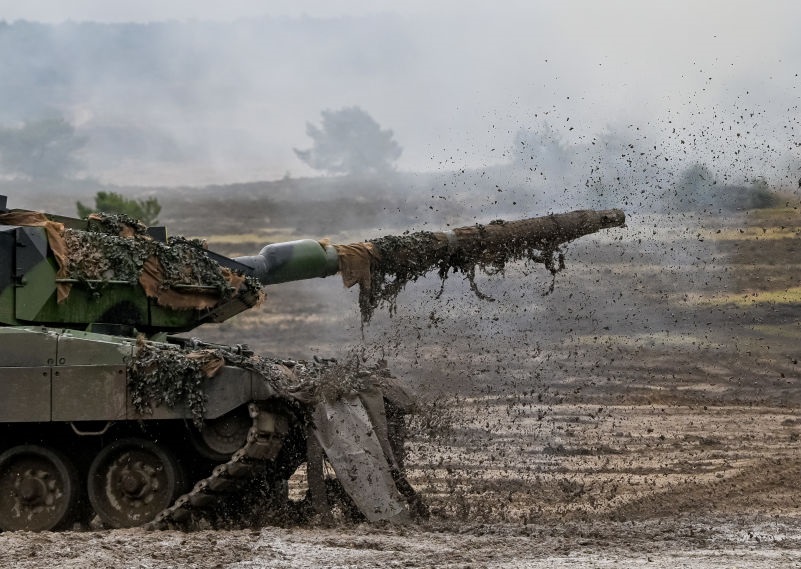Western tanks will bring their own complexities to Ukraine’s fight against Russia
Posted By Clive Williams on February 10, 2023 @ 06:00

The extensive debate about the provision of a relatively small number of Western tanks to Ukraine has created the impression in some quarters that the additional armour will be a game-changer. That’s unlikely to be the case.
Modern main battle tanks are complex pieces of equipment requiring a high level of crew training and expertise to operate effectively. For example, the US training course for the M1 Abrams tanks takes six months to complete.
A third-generation Western tank is a world away from the old basic Soviet-era tanks that Ukraine has been accustomed to operating. (Third-generation main battle tanks are characterised by composite armour and computer-stabilised fire-control systems that allow firing on the move, as well as very high first-hit probability on targets up to 2,000 metres away.)
Ukraine is likely to end up with a mix of 14 British Challenger 2s, 112 German Leopard 2s (only 14 in the short term) and 31 American M1 Abrams tanks. Delivery of the M1s could be delayed by US federal policy that forbids the export of tanks with classified content, which includes depleted uranium armour. Supply will therefore depend on availability of the less sophisticated export version of the M1. Ukraine could also end up with Leopard 2s from other donors, as well as 100 refurbished Leopard 1 tanks. In terms of military organisation, 14 tanks form a tank company and 56 a tank battalion.
Tank types have their own unique characteristics, and strengths and weaknesses, but something they share in common is that they are all fuel guzzlers, particularly the M1. Tanks operate on litres to the kilometre rather than the other way around.
Ukraine managed to limit Russia’s use of tanks in 2022 by targeting their vulnerable soft-skinned fuel-supply tankers. Without fuel, even the best tank in the world becomes a stationary artillery piece. For both fuel and maintenance reasons, tanks need to be transported to as close to the battlefield as possible. Transportation can be a challenge because a modern tank weighs around 60 to 70 tonnes.
It’s not yet clear whether the tanks being provided to Ukraine will be in new condition. Donor militaries tend to get rid of older equipment that is past its use-by date. Donations of large numbers of armoured vehicles might look good politically, but pre-loved vehicles will be of limited value to Ukraine because it lacks the capability to maintain old Western equipment. Australia has donated 28 M113 armoured personnel carriers, which could fall into that category.
What Ukraine wants is new equipment that can be run into the ground with minimal maintenance (much like the utes co-opted by terrorist groups such as al-Qaeda and Islamic State that were never serviced and still ran for 200,000 kilometres on poor roads before they expired).
Another factor to consider is the effectiveness of Russia’s anti-tank capabilities and the availability of anti-tank weapons in the forward areas of the battlefield.
In 2022, Ukraine made good use of Western anti-tank systems to deal a heavy blow to Russian armour, particularly during the initial months of the invasion when Russia had long and vulnerable lines of communication. Most effective were the FGM-148 Javelins [1] supplied by the US and the NLAWs [2] (next-generation light anti-tank weapons) from the UK. Crucially for Ukraine’s armed forces, the missiles were easy to transport and simple to use.
Little has been said about Russia’s anti-tank capability, but it has a range of weapons specifically designed to destroy NATO third-generation tanks. They include the 9M133 Kornet, a Russian man-portable anti-tank guided missile that was first introduced into service with the Russian army in 1998. It’s the Russian equivalent of the American Javelin.
Russia also has the RPG-29 [3] and RPG-30 [4], which were designed to defeat NATO third-generation tanks that have composite armour and explosive reactive armour. Explosive reactive armour is fitted to the exterior of a tank. When a penetrating warhead strikes the armour, the explosive component detonates, preventing the projectile from penetrating further. Reactive armour can be defeated with multiple hits in the same place, such as by tandem-charge weapons firing two or more shaped charges in rapid succession.
Russia’s operational tank fleet consists of various modifications of three main types: the T-72 [5], T-80 [6] and T-90 [7]. Russia probably has around 2,600 operational tanks. Ukraine can probably field around 600 tanks, mainly T-72s, including undamaged Russian tanks that ran out of fuel.
It seems unlikely that Ukraine will be able to crew and field an effective force of Western tanks before Russia mounts its threatened major offensive this year. NATO’s offer of 157 third-generation tanks to Ukraine, 129 of which will come later, won’t be enough to make a significant difference on the battlefield, but it may help boost Ukrainian army morale.
Article printed from The Strategist: https://www.aspistrategist.org.au
URL to article: https://www.aspistrategist.org.au/western-tanks-will-bring-their-own-complexities-to-ukraines-fight-against-russia/
URLs in this post:
[1] FGM-148 Javelins: https://missilethreat.csis.org/missile/fgm-148-javelin/
[2] NLAWs: https://en.wikipedia.org/wiki/NLAW
[3] RPG-29: http://www.military-today.com/firearms/rpg_29.htm
[4] RPG-30: http://www.military-today.com/firearms/rpg_30.htm
[5] T-72: https://en.wikipedia.org/wiki/T-72
[6] T-80: https://en.wikipedia.org/wiki/T-80
[7] T-90: https://en.wikipedia.org/wiki/T-90
Click here to print.